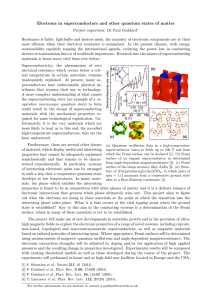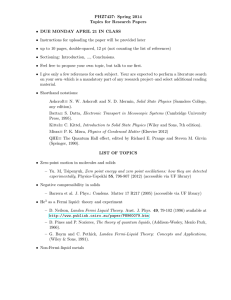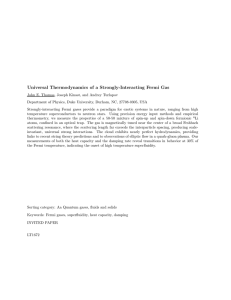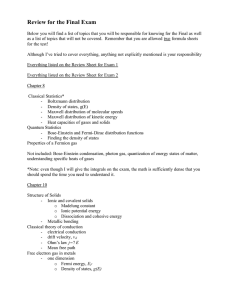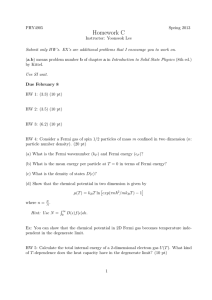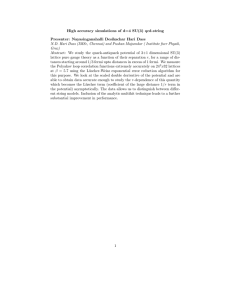Theory of high-temperature superconductivity and
advertisement
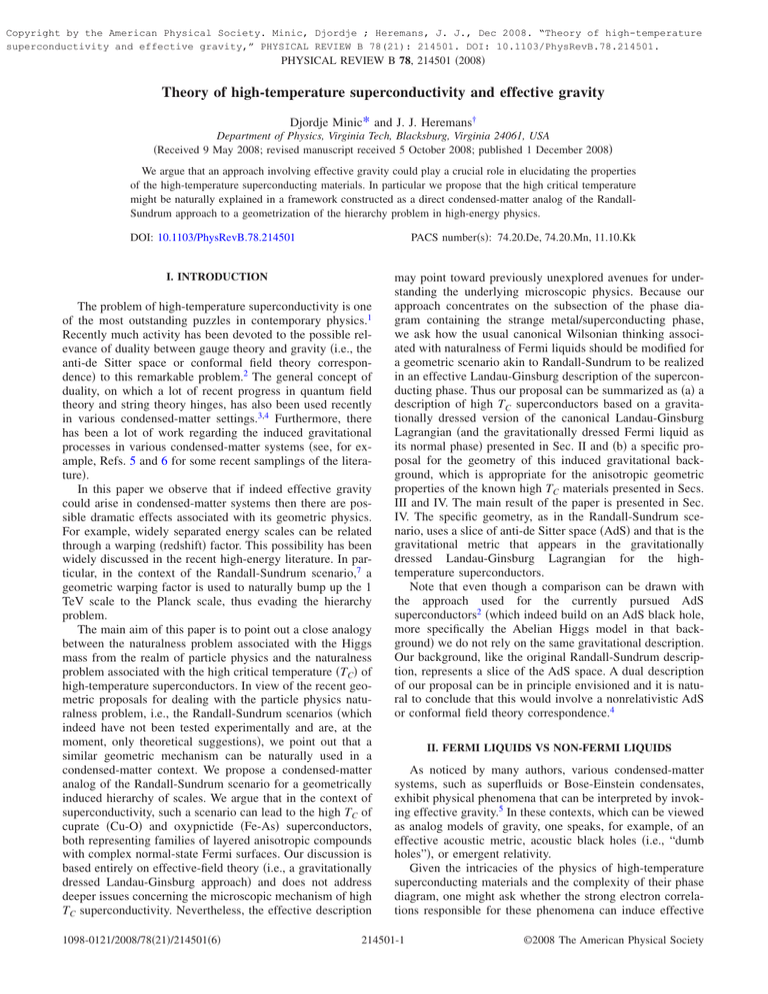
Copyright by the American Physical Society. Minic, Djordje ; Heremans, J. J., Dec 2008. “Theory of high-temperature superconductivity and effective gravity,” PHYSICAL REVIEW B 78(21): 214501. DOI: 10.1103/PhysRevB.78.214501. PHYSICAL REVIEW B 78, 214501 共2008兲 Theory of high-temperature superconductivity and effective gravity Djordje Minic* and J. J. Heremans† Department of Physics, Virginia Tech, Blacksburg, Virginia 24061, USA 共Received 9 May 2008; revised manuscript received 5 October 2008; published 1 December 2008兲 We argue that an approach involving effective gravity could play a crucial role in elucidating the properties of the high-temperature superconducting materials. In particular we propose that the high critical temperature might be naturally explained in a framework constructed as a direct condensed-matter analog of the RandallSundrum approach to a geometrization of the hierarchy problem in high-energy physics. DOI: 10.1103/PhysRevB.78.214501 PACS number共s兲: 74.20.De, 74.20.Mn, 11.10.Kk I. INTRODUCTION The problem of high-temperature superconductivity is one of the most outstanding puzzles in contemporary physics.1 Recently much activity has been devoted to the possible relevance of duality between gauge theory and gravity 共i.e., the anti-de Sitter space or conformal field theory correspondence兲 to this remarkable problem.2 The general concept of duality, on which a lot of recent progress in quantum field theory and string theory hinges, has also been used recently in various condensed-matter settings.3,4 Furthermore, there has been a lot of work regarding the induced gravitational processes in various condensed-matter systems 共see, for example, Refs. 5 and 6 for some recent samplings of the literature兲. In this paper we observe that if indeed effective gravity could arise in condensed-matter systems then there are possible dramatic effects associated with its geometric physics. For example, widely separated energy scales can be related through a warping 共redshift兲 factor. This possibility has been widely discussed in the recent high-energy literature. In particular, in the context of the Randall-Sundrum scenario,7 a geometric warping factor is used to naturally bump up the 1 TeV scale to the Planck scale, thus evading the hierarchy problem. The main aim of this paper is to point out a close analogy between the naturalness problem associated with the Higgs mass from the realm of particle physics and the naturalness problem associated with the high critical temperature 共TC兲 of high-temperature superconductors. In view of the recent geometric proposals for dealing with the particle physics naturalness problem, i.e., the Randall-Sundrum scenarios 共which indeed have not been tested experimentally and are, at the moment, only theoretical suggestions兲, we point out that a similar geometric mechanism can be naturally used in a condensed-matter context. We propose a condensed-matter analog of the Randall-Sundrum scenario for a geometrically induced hierarchy of scales. We argue that in the context of superconductivity, such a scenario can lead to the high TC of cuprate 共Cu-O兲 and oxypnictide 共Fe-As兲 superconductors, both representing families of layered anisotropic compounds with complex normal-state Fermi surfaces. Our discussion is based entirely on effective-field theory 共i.e., a gravitationally dressed Landau-Ginsburg approach兲 and does not address deeper issues concerning the microscopic mechanism of high TC superconductivity. Nevertheless, the effective description 1098-0121/2008/78共21兲/214501共6兲 may point toward previously unexplored avenues for understanding the underlying microscopic physics. Because our approach concentrates on the subsection of the phase diagram containing the strange metal/superconducting phase, we ask how the usual canonical Wilsonian thinking associated with naturalness of Fermi liquids should be modified for a geometric scenario akin to Randall-Sundrum to be realized in an effective Landau-Ginsburg description of the superconducting phase. Thus our proposal can be summarized as 共a兲 a description of high TC superconductors based on a gravitationally dressed version of the canonical Landau-Ginsburg Lagrangian 共and the gravitationally dressed Fermi liquid as its normal phase兲 presented in Sec. II and 共b兲 a specific proposal for the geometry of this induced gravitational background, which is appropriate for the anisotropic geometric properties of the known high TC materials presented in Secs. III and IV. The main result of the paper is presented in Sec. IV. The specific geometry, as in the Randall-Sundrum scenario, uses a slice of anti-de Sitter space 共AdS兲 and that is the gravitational metric that appears in the gravitationally dressed Landau-Ginsburg Lagrangian for the hightemperature superconductors. Note that even though a comparison can be drawn with the approach used for the currently pursued AdS superconductors2 共which indeed build on an AdS black hole, more specifically the Abelian Higgs model in that background兲 we do not rely on the same gravitational description. Our background, like the original Randall-Sundrum description, represents a slice of the AdS space. A dual description of our proposal can be in principle envisioned and it is natural to conclude that this would involve a nonrelativistic AdS or conformal field theory correspondence.4 II. FERMI LIQUIDS VS NON-FERMI LIQUIDS As noticed by many authors, various condensed-matter systems, such as superfluids or Bose-Einstein condensates, exhibit physical phenomena that can be interpreted by invoking effective gravity.5 In these contexts, which can be viewed as analog models of gravity, one speaks, for example, of an effective acoustic metric, acoustic black holes 共i.e., “dumb holes”兲, or emergent relativity. Given the intricacies of the physics of high-temperature superconducting materials and the complexity of their phase diagram, one might ask whether the strong electron correlations responsible for these phenomena can induce effective 214501-1 ©2008 The American Physical Society PHYSICAL REVIEW B 78, 214501 共2008兲 DJORDJE MINIC AND J. J. HEREMANS gravitational effects, thus opening a possibility for a geometric explanation of some of the outstanding puzzles. We concentrate on one such puzzle: the actual high value of the critical temperature. In particular, given the fact that in recent years high energy physicists have invoked gravity to explain the unnatural mass scale hierarchy, we propose a condensed-matter analog of the same mechanism. In the context of high-temperature superconductivity we argue for a geometric reinterpretation of the hierarchy that exists between the ordinary critical temperatures for low-temperature superconductors and their high-temperature relatives. This geometric reinterpretation may point to a new effective gravitational physics which may be responsible, among other things, for the high critical temperature of the hightemperature superconducting materials. A geometrically induced hierarchy of scales forces a revisiting of the Wilsonian approach to the Fermi surface to ascertain consequences for Fermi-liquid theory in the renormalization-group approach and for the emergence of non-Fermi-liquid behavior. From the effective-field theory standpoint, the question can be formulated: how does the low-energy Wilsonian action with effective gravity modify the usual scalings of the effective low-energy field theory of the Fermi surface? A. Fermi liquid To set the stage for our discussion let us summarize the classic effective-field theory of Landau Fermi liquids as most succinctly presented by Polchinski.8 One starts with a natural 共i.e., not finely tuned兲 Fermi surface and decomposes the momenta into the Fermi momentum and a component orthogonal to the Fermi surface pជ = kជ + ជl pole. Now, by considering four-Fermi interactions one can see that for generic momenta the four-Fermi interaction scales as a positive power of s and is thus irrelevant at low energy. The measure over time contributes one negative power, the measure over the momenta orthogonal to the Fermi surface contributes four powers, and the four-Fermi interaction contributes 4/2 negative powers. The delta function over the four momenta generically does not scale. So the overall generic scaling for the four-Fermi vertex is indeed s−1+4−4/2 = s1 . This is valid, except if the momenta are paired. In that case the scaling goes as s0 because now the delta function depends only on the sum of momenta orthogonal to the Fermi surface and due to ␦共sl兲 → s−1␦共l兲, kជ → kជ , 共1兲 ជl → slជ. 共2兲 共7兲 the four-Fermi interaction indeed scales as s0 and is marginal. This encapsulates the usual Cooper pairing phenomenon. Note that this scaling is true both in 2 + 1 and 3 + 1 dimensions, with the 2 + 1 dimensional case of interest for the layered anisotropic compounds. The case of 1 + 1 dimensions is special because then the Fermi surface consists of two points and hence the four-Fermi interaction is automatically marginally relevant. A one-loop calculation of the beta function does ensure the asymptotic freedom provided the interaction is perturbatively attractive, as is the case for phonon-electron interaction, which leads to the strongcoupling regime 共with bound states forming兲 in the infrared. The resulting wave function describing the superconducting state is of a BCS kind ⴱ 兲⌿FL , ⌿BCS ⬃ 兿 共␣ + aⴱk a−k and then one considers scaling of energy and momentum toward the Fermi surface. In other words E → sE, 共6兲 共8兲 k where ␣ and  are the usual variational parameters and aⴱ denote the creation operators of the electron quasiparticle. The lowest-order action, to quadratic order, is then given as SFL = 冕 冕 ⬅ B. Fermi liquid coupled to effective gravity LFL共, 兲 dtd3 pជ 兵iⴱ共pជ 兲t共pជ 兲 − 关E共pជ 兲 − EF共pជ 兲兴ⴱ共pជ 兲共pជ 兲其. 共3兲 Close to the Fermi surface E共pជ 兲 − EF共pជ 兲 ⬃ lvF, vF = pជ E, 共4兲 so that after the agreed renormalization orthogonal to the Fermi surface 共note that also t → s−1t兲 one obtains, in both 2 + 1 and 3 + 1 space-time dimensions, → s−1/2 . 共5兲 Note that this scaling leads immediately to the usual twopoint function for a free quasiparticle with a single-particle In what follows we outline an intuitive argument for the crucial relevance of an effective gravitational description of the normal state of the high TC materials. How could effective gravity arise from the dynamics of the Fermi surface? First, we note that experiments indicate a highly irregular Fermi surface in the normal state, resulting from the microscopic physics.1 This irregularity in turn could lead to an effective gravitational description. As a concrete model, let us view the Fermi surface as an incompressible fluid in momentum space. Then in analogy with the discussion of induced gravity in fluid dynamics5,9 we can envision generating an effective metric, which in the case of real irrotational fluids is precisely the acoustic metric.9 This effective metric is generated from the fluctuations of the fluid density and the velocity potential 共where the velocity vជ = ⵜ兲. The underlying space-time action of the moving fluid is 214501-2 PHYSICAL REVIEW B 78, 214501 共2008兲 THEORY OF HIGH-TEMPERATURE SUPERCONDUCTIVITY… S= 冕 冋 册 ˙ + 1 共ⵜ兲2 + U共兲 , dx4 2 共9兲 with U共兲 denoting the effective potential. Note that the signs in S are consistently defined so that upon the variation of this action one obtains the equations of motion for and 共the Euler continuity equation and the Bernoulli energy balance equation兲.5 Note also that the pressure is the negative of the action density in the expression for S. When these equations of motion are perturbed around the equilibrium values 0 and 0 one is led to the equations for the fluctuations of the velocity potential . In particular, the equation for the fluctuations of the velocity potential can be written in a geometric form9 1 冑− g a共 冑− ggabb兲 = 0. 共10兲 The effective space-time metric has the canonical ArnowittDeser-Misner form of Refs. 5 and 9 共apart from a conformal factor兲 and has the Lorentzian signature ds2 = 0 2 2 关c dt − ␦ij共dxi − vidt兲共dx j − v jdt兲兴, c 共11兲 where c is the sound velocity 共or a plasmon velocity for a system of charged fermions兲 and vi are the components of the fluid’s velocity vector. Note that the collective dynamics of the Fermi surface can be considered as a “bosonization” of the Fermi liquid10 and in that approach the quasiparticle excitations can be represented by a collective mode of the “bosonized” Fermi liquid. That approach runs into trouble with the essential difference between fermions and bosons in spatial dimensions 1 共where the bosonization can be used because of the very special kinematics兲 and spatial dimensions above 1, where such efforts are largely prohibitive.10 In contrast, in our proposal the non-Fermi-liquid behavior originates from the gravitational dressing, itself caused by the nontrivial geometry and topology of the Fermi surface: an experimental fact. Thus we argue that these quasiparticles are the usual fermions, but propagating in a nontrivial gravitational background and hence dressed by the gravitational fluctuations. In other words, the collective motion of the Fermi surface is of an effective gravitational kind 共i.e., not spin 0 but spin 2兲 and the usual fermionic quasiparticles are now coupled to this collective spin 2 bosonic mode. Thus we propose that the effective theory of the strange normal state of high TC superconductors is a gravitationally dressed Fermi liquid, i.e., the usual Fermi liquid albeit coupled to gravity SNFL = 冕 dDx冑− gLFL共,ⵜ兲. 共12兲 This general discussion of the gravitationally dressed Fermi liquid applies to both dimensionalities D = 2 + 1 and D = 3 + 1. For the normal state of the Cu-O or Fe-As planes, D = 2 + 1 is relevant. Applying this approach to the Fermi surface in momentum space, by relying on the induced effective diffeomorphism invariance, we are led to conclude that the effective action for the fermionic quasiparticle around the Fermi surface should be a gravitationally dressed action, in which the naive scaling dimensions discussed above can be changed by adding gravitational dressing. In general this would mean that instead of → s−1/2 as discussed above, we should have → s−1/2+␣ , 共13兲 where ␣ denotes gravitational dressing. Such dressing can be explicitly computed in simple cases such as the coupling of two-dimensional gravity to two-dimensional matter.11 Thus the fermionic two-point function can be changed to scale as s−1+2␣, indicative of a non-Fermi-liquid behavior. Naturally, the anomalous dimensions of Fermi propagators have been considered previously, in the marginal Fermiliquid theory, through couplings with an effective induced gauge field, in the context of quantum critical fixed points, and other proposals.1,12,13 Our proposal is not unique in placing emphasis on the anomalous fermionic propagators. Also, the phenomenology implied by anomalous fermionic propagators, including non-Fermi-liquid behavior such as a resistivity linear in temperature T,12 is inherent to our proposal as well. In this scenario, the normal state is described by a gravitationally dressed Fermi-liquid theory. Similarly, the BCS wave function would be gravitationally dressed. Note that our discussion is couched in terms of an effective-field theory and therefore does not carry information about the underlying microscopic mechanism. In particular, the specific nature of the pairing mechanism and its relationship with the effective gravitational description is outside the scope of the present approach. The approach generally does conclude that the usual effective Landau-Ginsburg theory describing the physics of the condensate is gravitationally dressed as follows 共D = 2 + 1 or D = 3 + 1兲: SLGg = 冕 dDx冑− g关gⵜHⴱⵜH − V共兩H兩2兲兴, 共14兲 where the complex order parameter is denoted by H and V共兩H兩2兲 is an effective potential 共for example, of a quartic type兲. In what follows, most important is that such a gravitationally dressed Landau-Ginsburg theory leads to a simple geometric mechanism for the high TC of high-temperature superconductors. III. EFFECTIVE GRAVITY AND ENERGY SCALE HIERARCHY To implement a condensed-matter analog of the gravitationally induced energy scale hierarchy, we first present a brief summary of the Randall-Sundrum proposal7 which precisely accomplishes this goal. The exponential hierarchy is induced by a warped extra dimensional geometry. The actual example envisions two three-branes 共i.e., two 3 + 1 dimensional worlds兲, separated by a distance of rc in one extra 共fifth兲 spatial dimension. This bulk 4 + 1 dimensional space represents a portion of the 4 + 1 dimensional AdS space, whose cosmological constant is determined by another pa- 214501-3 PHYSICAL REVIEW B 78, 214501 共2008兲 DJORDJE MINIC AND J. J. HEREMANS rameter of the model k. One of the branes carries the degrees of freedom of the standard model. The other carries the Planck scale degrees of freedom. This setup can be carried over from dimensionality D = 3 + 1 to D = 2 + 1. In the layered anisotropic compounds, the Cu-O or Fe-As planes can be identified with 2 + 1 dimensional branes and D = 2 + 1 hence is relevant. The extra anisotropic dimension is to be identified with the actual anisotropy of these materials. The crucial assumption in this setup is that effective gravity is induced, perhaps by the internal dynamics of geometrically very complicated Fermi surfaces. The warped geometry of the extra dimension could originate from the interlayer coupling. We address the question of how the effective gravitational description could be induced from the dynamics of the Fermi surface in Sec. IV. Concerning the Randall-Sundrum scenario in the anisotropic compounds, the 2 + 1 dimensional branes separated in an extra anisotropic spatial dimension lead to the following bulk 3 + 1 dimensional metric: ds2 = r2c du2 + e−2krcudxdx . 共15兲 Here u denotes the extra anisotropic spatial direction of size lc and , = 0 , 1 , 2 are the 2 + 1 dimensional 共planar兲 spacetime indices. Also, is the planar flat 共Minkowski兲 spacetime metric. The gravitational fluctuations h around the flat Minkowski metric define the background metric g0 = + h.7 For D = 2 + 1, the low-energy effective action for a Higgs field 共order parameter兲, i.e., the Landau-Ginsburg action coupled to effective gravity, is SLGg = 冕 d2+1x冑− g关gⵜHⴱⵜH − 共兩H兩2 − v20兲2兴, The question arises why the Randall-Sundrum warp factor should occur in the interlayer coupling. We notice that the physics of interlayer tunneling considered in the past13 naturally involves exponential wave functions and thus can be directly compared to the geometric exponential factors that appear in the Randall-Sundrum case. Thus the proposed geometrization captures the relevant interlayer physics, at least on the level of an effective, and not microscopic, description. Here we emphasize the weak nature of the interlayer coupling as opposed to the strong intralayer coupling; the latter leading to non-Fermi-liquid behavior and induced gravitational dressing as argued in Sec. II. Finally we remark that in principle the geometric argument applies to both cuprates and oxypnictides and indeed stresses the very features they bear in common. IV. WHY HIGH Tc? Here we present a simple computation of TC based on the gravitationally dressed Landau-Ginsburg effective description and the geometric argument presented above. This constitutes the main result of this paper. Remembering the usual BCS dispersion relation given a gap ⌬, E = 冑⌬2 + k2 , in which the gap plays the role of the Higgs mass 共given the well-known analogy with the relativistic dispersion relation for a particle of mass m, i.e., E = 冑m2 + k2兲, we see that there exists a distinct possibility of similarly warping the gap, as in Eq. 共5兲, and thus warping the TC. Normally TC is related to the gap evaluated at low momenta15 共16兲 where 共Ref. 7兲 and g is the determinant of g. After rescaling the Higgs field 共the Landau-Ginsburg order parameter兲 H → ekrclcH the effective action for D = 2 + 1 becomes g = e−2krclcg0 SLGg = 冕 d 2+1 x冑− g 关g 0 0 ⴱ ⵜH ⵜH − 共兩H兩 − 2 e−2krclcv20兲2兴. 共17兲 Note that we can take lc = as in Ref. 7. Thus the physical mass scale is given by a blueshifted symmetry-breaking scale 共where v0 is the minimum of the potential兲 v = v0e−krc , 共18兲 or alternatively, the relevant mass scales are related as m = m0e−krc . 共19兲 This is the key result. Thus in order to obtain m0 ⬃ 1019 GeV and m ⬃ 1 TeV one only needs to require krc ⬃ 50. Note that even though this result has been derived in an effective-field theory, there exists an ultraviolet 共UV兲 completion of this scheme from the point of view of string theory.14 In particular, the complex issue of stability of the Randall-Sundrum scenario requires a UV complete description. 共20兲 TC = const⌬共0兲. 共21兲 In the superconductors considered, one obtains a geometrically shifted temperature so that the following relation results: THTc = TCekrc . 共22兲 Here TC denotes the low critical temperature of conventional superconductors—typically a few K. THTc denotes the critical temperature of high TC superconductors—equal to around 50–150 K. Therefore, a high TC naturally arises from the above exponential factor that is responsible for a hierarchy of energy scales. An exponential factor multiplying the usual 1–10 K critical temperature 共determined by the value of the BCStype gap at zero momenta兲 produces a new critical temperature in the 50–150 K range or higher. The representative samples of, from top to bottom, cuprate, oxypnictide 共Fe-As兲,16 BCS type II, and BCS type I superconducting critical temperatures are collected in Table I. For example, transitioning from the lowest 共Al兲 to the highest 共Tl compound兲 requires only an argument of 5 in the exponent. V. CONCLUSIONS In this paper we have proposed a condensed-matter analog of the Randall-Sundrum scenario for a geometrically in- 214501-4 PHYSICAL REVIEW B 78, 214501 共2008兲 THEORY OF HIGH-TEMPERATURE SUPERCONDUCTIVITY… TABLE I. Representative samples of cuprate, oxypnictide 共FeAs兲, BCS type II, and BCS type I superconducting critical temperatures. Compound TC 共K兲 Tl2Ba2Ca2Cu3O10 Bi2Sr2Ca2Cu3O10 YBa2Cu3O7 La2−xSrxCuO4 SmFeAsO0.85F0.15 CeFeAsO0.84F0.16 LaFeAsO0.89F0.11 Nb3Sn NbTi Pb Al 125 110 92 38 42 41 26 18 10 7.2 1.1 ACKNOWLEDGMENTS duced hierarchy of scales. We have argued that in the context of the physics of high-temperature superconductivity, such a scenario can be responsible for the high TC of cuprate and oxypnictide superconductors. The conjecture spontaneously leads to emphasis on the unusual features shared by cuprates and oxypnictides. Needless to say we have only scratched the surface of the manifold of issues relevant for high TC superconductivity. Of primary importance remains a specific *dminic@vt.edu †heremans@vt.edu 1 E. microscopic mechanism as well as a more detailed phenomenology derived from the gravitationally dressed LandauGinsburg approach. Apart from advancing understanding of the unusual normal as well as the superconducting phase, this approach can illuminate other parts of the phase diagrams of high-temperature superconductors. For instance, of future interest are the relevance of spin-spin interaction17 for the effective gravitational description proposed in this paper, a study whether the d-wave nature of the order parameter1 naturally follows from a gravitationally dressed LandauGinsburg description, an understanding of the pseudogap region of the phase diagram, and finally connecting the recent discussion of Mottness18 to our context. These and other questions are left for more detailed future work. W. Carlson, V. J. Emery, S. A. Kivelson, and D. Orgad, The Physics of Conventional and Unconventional Superconductors, edited by K. H. Bennemann and J. B. Ketterson 共SpringerVerlag, Berlin, 2008兲. 2 For example, S. A. Hartnoll, P. K. Kovtun, M. Muller, and S. Sachdev, Phys. Rev. B 76, 144502 共2007兲; S. A. Hartnoll and C. P. Herzog, Phys. Rev. D 76, 106012 共2007兲; S. A. Hartnoll, C. P. Herzog, and G. T. Horowitz, Phys. Rev. Lett. 101, 031601 共2008兲; S. S. Gubser and S. S. Pufu, arXiv:0805.2960 共unpublished兲. 3 For example, C. P. Herzog, P. Kovtun, S. Sachdev, and D. T. Son, Phys. Rev. D 75, 085020 共2007兲; J. J. Heremans and D. Minic, arXiv:0802.4117v2 共unpublished兲; D. Minic and M. Pleimling, arXiv:0807.3665, Phys. Rev. E共to be published兲. 4 D. T. Son, Phys. Rev. D 78, 046003 共2008兲; K. Balasubramanian and J. McGreevy, Phys. Rev. Lett. 101, 061601 共2008兲, and references therein. 5 M. Visser, L. Garay, U. Leonhardt, T. Jacobson, T. Koike, W. Unruh, G. Volovik, G. Chapline, B. Carter, R. Parentani, M. Novello, H. Rosu, and M. Stone, Artificial Black Holes, edited by M. Novello, M. Visser, and G. Volovik 共World Scientific, Singapore, 2002兲. 6 Grigory E. Volovik, The Universe in a Helium Droplet 共Oxford University Press, New York, 2003兲. 7 L. Randall and R. Sundrum, Phys. Rev. Lett. 83, 3370 共1999兲. 8 J. Polchinski, in Effective Field Theory and the Fermi Surface, We would like to thank R. G. Leigh, Philip Phillips, Joseph Polchinski, and Victoria Soghomonian for lending their ears to a preliminary version of this proposal. Many thanks to Laurent Freidel, Vishnu Jejjala, and Nemanja Kaloper for comments on the draft of this paper. D.M. is supported in part by the U.S. Department of Energy under Contract No. DE-FG05-92ER40677. J.J.H. is supported in part by the National Science Foundation under Contract No. DMR0618235. edited by J. Harvey and J. Polchinski 共World Scientific, Singapore, 1993兲; R. Shankar, Rev. Mod. Phys. 66, 129 共1994兲. 9 W. G. Unruh, Phys. Rev. Lett. 46, 1351 共1981兲; D. Kominis and V. Koulovassilopoulos, Phys. Rev. D 51, 282 共1995兲. 10 A. Luther, Phys. Rev. B 19, 320 共1979兲; R. Abhiraman and C. M. Sommerfield, Gursey Memorial Conference I 共Bogazici Univerisity, Istanbul, Turkey, 1994兲; C. M. Sommerfield, in Celebration of 60th Birthday Anniversary of Feza Gursey, Aprril 1981, Yale Gursey Symposium, 1981, edited by I. Bars, A. Chodos, and C.-H. Tze 共Plenum, New York, 1984兲; A. Enciso and A. P. Polychronakos, Nucl. Phys. B 751, 376 共2006兲; F. D. M. Haldane, in Proceedings of the International School of Physcis, Enrico Fermi, Course CXXI, Perspectives in Many-Particle Physics, edited by R. A. Broglia and J. R. Schrieffer 共NorthHolland, Amsterdam, 1994兲; A. Houghton and J. B. Marston, Phys. Rev. B 48, 7790 共1993兲; A. H. Castro Neto and E. Fradkin, Phys. Rev. Lett. 72, 1393 共1994兲, and references therein. 11 V. G. Knizhnik, A. M. Polyakov, and A. B. Zamolodchikov, Mod. Phys. Lett. A 3, 819 共1988兲. 12 See, for example, C. M. Varma, P. B. Littlewood, S. SchmittRink, E. Abrahams, and A. E. Ruckenstein, Phys. Rev. Lett. 63, 1996 共1989兲; see, also the recent paper, E. Kapit and A. LeClair, arXiv:0805.2951 共unpublished兲. 13 See, for example, the relevant discussion in P. W. Anderson, The Theory of Superconductivity in the High-TC Cuprates 共Princeton, Princeton, NJ, 1997兲. 14 S. B. Giddings, S. Kachru, and J. Polchinski, Phys. Rev. D 66, 106006 共2002兲. 214501-5 PHYSICAL REVIEW B 78, 214501 共2008兲 DJORDJE MINIC AND J. J. HEREMANS 15 See, for example, R. P. Feynman, Statistical Mechanics : A Set of Lectures 共Addison-Wesley, Reading, MA, 1998兲. 16 T. Y. Chen, Z. Tesanovic, R. H. Liu, X. H. Chen, and C. L. Chien, Nature 共London兲 453, 1224 共2008兲; G. F. Chen, Z. Li, D. Wu, G. Li, W. Z. Hu, J. Dong, P. Zheng, J. L. Luo, and N. L. Wang, Phys. Rev. Lett. 100, 247002 共2008兲; Y. Kamihara, T. Watanabe, M. Hirano, and H. Hosono, J. Am. Chem. Soc. 130, 3296 共2008兲; A. S. Sefat, M. A. McGuire, B. C. Sales, R. Jin, J. Y. Howe, and D. Mandrus, Phys. Rev. B 77, 174503 共2008兲. 17 P. Monthoux, D. Pines, and G. G. Lonzarich, Nature 共London兲 450, 1177 共2007兲. 18 R. G. Leigh, P. Phillips, and T. P. Choy, Phys. Rev. Lett. 99, 046404 共2007兲; Ting-Pong Choy, Robert G. Leigh, Philip Phillips, and Philip D. Powell, Phys. Rev. B 77, 014512 共2008兲. 214501-6
